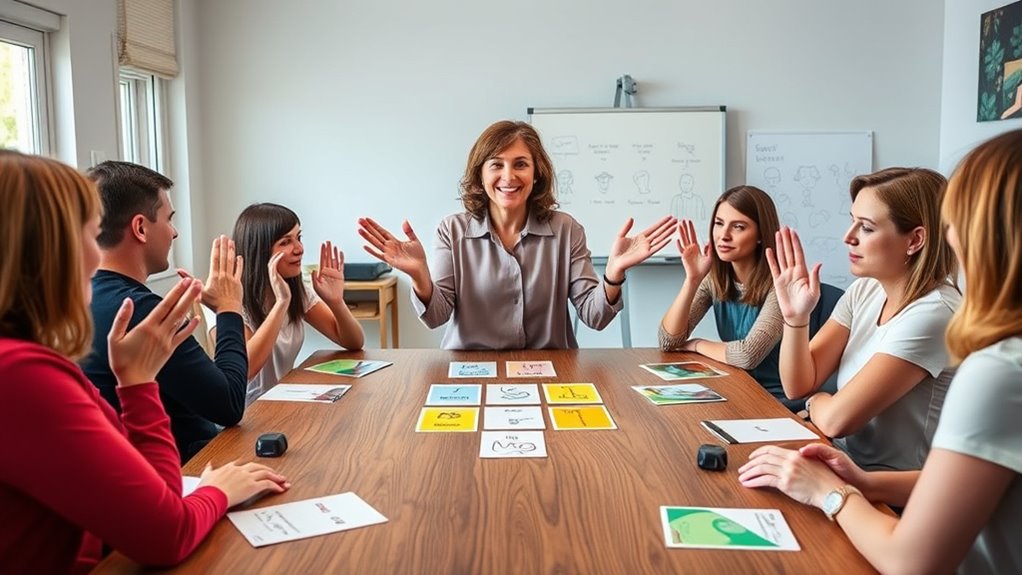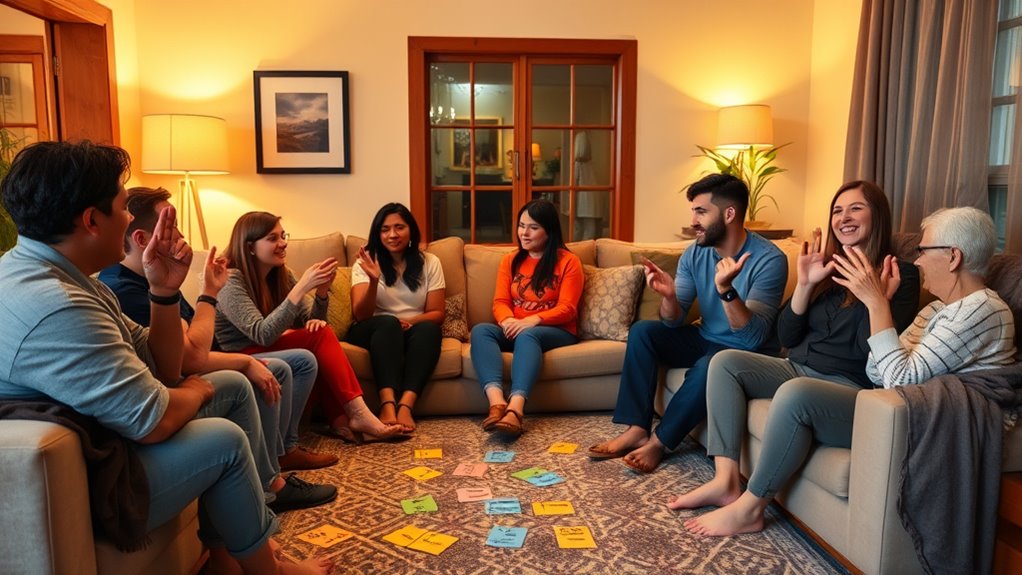To teach friends basic sign language in one evening, focus on common, practical signs like hello, thank you, please, and sorry. Gather visual aids such as flashcards or videos, then demonstrate each sign clearly. Keep sessions interactive with fun activities like sign charades or practice pairs. Maintain a positive, patient atmosphere, and limit the session to 30-45 minutes to avoid fatigue. If you keep exploring, you’ll discover even more effective ways to learn and share sign language.
Key Takeaways
- Focus on practical, everyday signs like hello, thank you, please, and sorry for quick mastery.
- Use visual aids such as flashcards or videos to demonstrate correct hand positions clearly.
- Incorporate fun activities like sign charades or quick quizzes to keep the session engaging.
- Keep the session within 30-45 minutes, balancing learning with interactive practice to prevent fatigue.
- Provide positive feedback and encouragement to boost confidence and reinforce retention.
Prepare Your Materials and Set Clear Goals

Have you gathered everything you need before starting to teach sign language? Preparing your materials is essential. Begin by understanding the signing history and cultural significance behind certain signs; this context helps your friends appreciate the language’s depth. Use clear, visual resources like flashcards, videos, or online tutorials to demonstrate signs effectively. Set specific, achievable goals for the session—such as mastering basic greetings or common phrases—so everyone stays focused. Decide on the signs you’ll cover, ensuring they’re useful and relevant. Having a well-structured plan keeps the session engaging and efficient. Remember, knowing the background of sign language fosters respect and appreciation, making the learning experience more meaningful for everyone involved. Additionally, incorporating powerful persuasive words can motivate your friends and boost their confidence in acquiring new skills.
Focus on Common and Useful Signs

Once you’ve gathered your materials and set clear goals, it’s important to focus on teaching signs that your friends will find most useful in everyday conversations. Prioritize common signs like greetings, thank you, and please. Understanding the cultural context helps you choose signs that are relevant and respectful. Also, emphasize correct sign pronunciation, ensuring your friends can replicate signs accurately. Here’s a helpful chart:
| Sign | Use Case |
|---|---|
| Hello | Greeting in most contexts |
| Thank you | Showing appreciation |
| Please | Making polite requests |
| Sorry | Apologizing and showing empathy |
Focusing on these practical signs makes learning more meaningful and instantly applicable, helping your friends communicate confidently and respectfully. Additionally, practicing electric bike speeds can inspire discussions about different modes of transportation and their benefits.
Use Visuals and Demonstrations for Effective Learning

Using visuals and demonstrations substantially enhances the learning process because they provide clear, immediate examples of how signs are performed. When you show signs visually, your friends can better grasp gesture recognition and finger spelling. Seeing signs in action helps them understand hand shapes, movements, and facial expressions *vital* for effective communication. To maximize understanding, incorporate:
- Live demonstrations to showcase proper hand positioning
- Visual aids like diagrams or videos highlighting gesture recognition
- Practice sessions where learners mimic signs immediately
- Clear, slow finger spelling examples for beginners
These methods make abstract signs concrete, reducing confusion. Visuals help your friends remember signs longer and build confidence faster, making your teaching session both engaging and effective. Additionally, understanding the importance of color accuracy in visual representations can improve the clarity of your demonstrations.
Incorporate Fun Activities to Reinforce Signs

To reinforce signs effectively, try incorporating fun activities like interactive games and challenges that keep everyone engaged. Using visual aids and flashcards can also make learning signs more memorable and enjoyable. Group sign practice sessions encourage teamwork and help everyone improve together. Incorporating performance metrics can help track progress and identify areas needing improvement during practice.
Interactive Games and Challenges
Have you ever wondered how to make learning sign language fun and memorable? Interactive games and challenges are perfect for reinforcing signs while keeping everyone engaged. These activities help you explore cultural differences and expand your vocabulary, even with advanced words. Try:
- Sign charades, where you act out signs for others to guess.
- Vocabulary relay, moving through signs quickly to build fluency.
- Sign storytelling, creating short narratives with new signs.
- Cultural comparison games, discussing differences in gestures across regions.
These activities boost confidence and retention, making learning feel less like a chore and more like a fun challenge. Plus, they encourage communication, collaboration, and cultural awareness—all essential for mastering basic sign language efficiently.
Visual Aids and Flashcards
Interactive games and challenges make learning sign language lively and memorable, but incorporating visual aids and flashcards can take your practice to the next level. These tools help improve gesture recognition by providing clear, visual references for each sign. When signs are simple, flashcards reinforce quick recall, but for more complex signs, visual aids break down each movement step-by-step. You can create flashcards with pictures or demonstrations, making it easier to distinguish subtle differences in hand shapes and motions. Incorporating these aids into your activities boosts visual learning and helps your friends grasp sign complexity faster. Plus, they add variety and fun, making the evening engaging and effective for everyone involved.
Group Sign Practice Sessions
Why not turn sign practice into a lively group activity that everyone will enjoy? Group sign practice sessions make learning fun and effective. Encourage participants to customize gestures, adding personal flair that boosts gesture customization and makes signs more memorable. You can organize games like charades where everyone signs words or phrases, fostering sign memorization through repetition. Pair up participants for quick-fire sign challenges, or hold a mini-competition to see who can recall the most signs. These activities break the ice and reinforce learning naturally. Incorporating fun activities helps everyone stay engaged and improves retention. Plus, it builds confidence as friends support each other in mastering basic signs together. Keep the atmosphere relaxed, and watch everyone’s signing skills improve effortlessly. Additionally, using multisensory learning techniques can enhance memory and facilitate easier recall of signs during practice sessions.
Encourage Practice and Interactive Communication

How can you make learning basic sign language effective and enjoyable? By encouraging practice and interactive communication, you help your friends build confidence. Incorporate role playing exercises to simulate real-life conversations, making the learning relevant and fun. These exercises foster spontaneous signing and boost comfort levels. Additionally, storytelling techniques can make lessons engaging; by narrating simple stories with signs, your friends connect meaning to each gesture. Encourage them to practice regularly, whether through quick daily chats or group activities. Creating a supportive environment where mistakes are part of learning keeps motivation high. The key is to make signing feel natural and interactive, turning practice into an enjoyable experience that cements their skills quickly. Engaging in virtual hackathons or online collaborative activities can also introduce new ways to practice and stay motivated in a dynamic learning environment.
Keep the Session Short, Engaging, and Supportive

Ever wonder what makes learning sign language more effective? Keeping your session short, engaging, and supportive helps everyone stay motivated and attentive. It’s important to respect sign language etiquette and cultural awareness, which fosters comfort and understanding. To maintain momentum, consider these tips:
- Limit sessions to 30-45 minutes to prevent fatigue
- Incorporate fun, hands-on activities that encourage interaction
- Use positive reinforcement to boost confidence
- Be patient and attentive to your friend’s pace and comfort levels
- Remember that attention to detail ensures effective communication and learning outcomes
This approach keeps learning enjoyable and respectful, ensuring your friend feels supported. Short, engaging sessions help solidify skills without overwhelming, making the experience memorable and empowering for both of you.
Frequently Asked Questions
How Can I Tailor Signs to Suit My Friends’ Specific Interests?
You can tailor signs to your friends’ interests by incorporating personalized signs and interest-based vocabulary. Observe what topics or hobbies they enjoy, then find or create signs related to those areas. Use visual cues or objects that resonate with their passions to make learning engaging. This approach helps them connect more deeply with the signs, making the experience fun and relevant. Customizing signs keeps their motivation high and accelerates their learning process.
What Are Some Signs Best Learned Through Everyday Objects?
You should focus on signs that are best learned through everyday objects and common household items. For example, use a spoon or a cup to teach signs like eat or drink. Point to a book for sign reading and use keys for sign key. Incorporate these objects into your lessons, making learning more intuitive and memorable for your friends. This hands-on approach helps reinforce signs naturally.
How Do I Handle Mistakes or Misremembered Signs During Practice?
When you encounter mistakes or misremembered signs during practice, stay patient and focus on error correction. Gently correct errors, clarify misunderstandings, and encourage perseverance. Repetition helps reinforce learning, so repeat signs clearly and confidently. Keep a positive attitude, celebrate small wins, and remind your friends that mistakes are part of learning. By staying supportive and persistent, you create a comfortable environment that fosters progress and confidence in signing.
Are There Recommended Resources for Continued Sign Language Learning?
You should explore online courses and sign language apps to continue your learning journey. These resources offer flexible, interactive lessons that reinforce your skills and expand your vocabulary. Many apps also include practice games and videos, making learning engaging. Online courses often provide structured guidance and community support. Using these tools regularly helps you build confidence and fluency, ensuring your signing improves even after your initial introduction.
How Can I Motivate My Friends to Keep Practicing After the Session?
Motivating your friends is like lighting a spark that can turn into a blazing fire. You can keep their interest alive with fun icebreakers and group challenges that make practicing feel like play, not work. Celebrate small wins, share progress, and create a supportive environment. By making learning engaging and rewarding, your friends will stay motivated and excited to keep practicing long after your initial session.
Conclusion
By keeping things simple, engaging, and supportive, you’ll make learning basic sign language enjoyable for your friends. Remember, you’re planting seeds that can grow into lifelong skills, so don’t expect perfection overnight. Patience is key, and the more you practice together, the easier it becomes. If you keep the mood light and fun, everyone will stay motivated. After all, Rome wasn’t built in a day, but with steady effort, your friends will be signing in no time.











